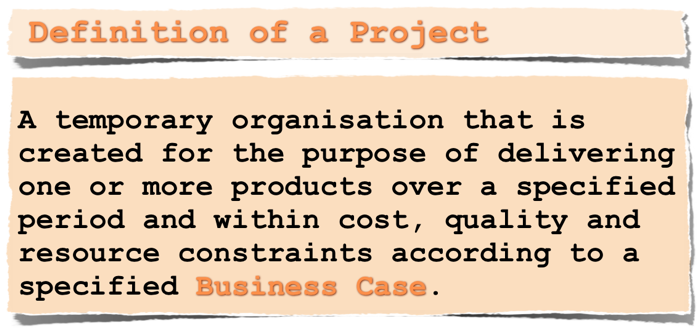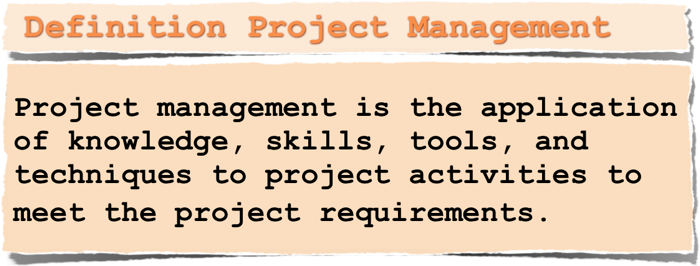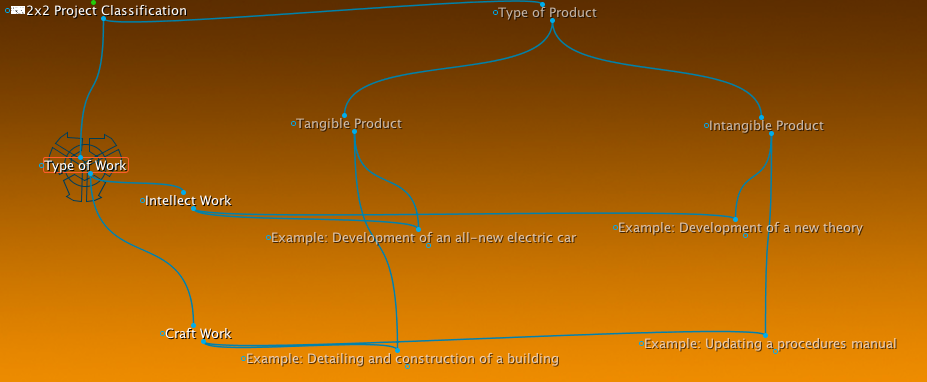Succesful project with Prince2 (SPP2)
SPP2 - Lesson 7: Directing a Project
in this lesson we will cover the process of Directing a Project
Subjects covered in the lesson:
DP Purpose
DP Objective
DP Context
DP Activities
There are n videos in this lesson:
Introduction
Defining Project Risk
- One of a Kind
- Temporary
- Constrained
- Change
- Cross Functional
- Uncertainty
- Knowledge
- Skills
- Techniques
- Tools
- ATTITUDE
Project Types
- Type of work
- Craft
- Intelect
- type of Product
- Tangible
- Intangible
- Level of Uncertainty
- Level of Complexity
- Level of Pace
- Culture
- Application area / Industry
- Life-cycle stage
- Strategic Importance
Project Success
Key Characteristics of Prince2
- Public Domain
- Based on Best Practices
- Common Project Language
- Certifications
- Foundation
- Practioner
Benefits of Prince2
- Better planning and communication
- Can be applied to any type of project
- Clarity of Roles and Responsibilities
- Consistency
- Easy assessment
- Management by exception
- Promotes learning
- Proven Best practice for projects governance
- Results oriented not task oriented
- Widely Recognized
Structure of Prince2
Prince2 Principles
- Business Justification
- Learn from experience
- Manage by exception
- Manage by stage
- Product focus
- Roles and responsibilities
- Tailor
2.1 Continued Business Justification
A PRINCE2 project has continued business justification.
A requirement for a PRINCE2 project is:
- There is a justifiable reason to start it
- The justification should remain valid throughout the life of the project.
The justification can change!
And as a result the project objectives/deliverables may change!
The justification is documented and approved
DON'T start a project without business justification
STOP the project when there no longer is
a valid business justification
2.2 Learn from experience
PRINCE2 project teams learn from previous experience: lessons are thought, recorded and acted upon throughout the life of the project.
- When starting a project
- As the project progresses
- As the project closes
This needs to be a proactive principle. IOW, don't wait for someone else to tell.
Lessons can be learned on multiple levels. Individual, team, project, organization.
Remember that past success is no guarantee for future success.
Also be aware of the Knowing - Doing Gap.
2.3 Defined Roles & Responsibilities
A PRINCE2 project has defined and agreed roles and responsibiities within an organization structure that engages the business, user and supplier stakeholder interests.
All projects have the following primary stakeholders:
the business/sponsor owns the project. A project is done on behalf of the business, its purpose is to fulfil a certain business objective. The business has to make a choice whether to fund a project fund another project or just bank the money.
The outcome of a project will be used by the user. It is therefore important that the user is represented on the project board.
The outcome of the project is produced by the supplier. This can be either a internal or external supplier.
2.4 Manage by Stages
A PRINCE2 project is planned, monitored and controlled on a stage-by-stage basis.
PRINCE2 overcomes the planning horizon by:
Dividing the project into a number of management stages
Having a high level project plan and a detailed stage plan
Planning, delegating, monitoring and controlling the project on a stage-by-stage basis
A management stage is not the same as a production stage.
P2 requires there to be a minimum of 2 management stages:
Initiation stage
(further) management stage(s)
Note that Starting Up a project (SU) is NOT a management stage!
2.5 Manage by Exception
"No news is good news"
This can only be achieved when there is sufficient planning and information available. It does require a new, or adjusted, attitude by all parties involved.
2.6 Product Focus
A task without a specific deliverable is meaningless. In the end of the day projects produce products.
2.7 Tailor to suit the project environment
Themes
- Business Case
- Change
- Organization
- Plans
- Progress
- Quality
- Risk
Processes
SPP2 - Lesson 8: Project Organization
in this lesson we will cover the Project Organization
Subjects covered in the lesson:
Purpose of Organization
Organization defined
The PRINCE2 Approach to Organization
Organization roles & responsibilities
There are n videos in this lesson:
Introduction
Defining Project Risk
- One of a Kind
- Temporary
- Constrained
- Change
- Cross Functional
- Uncertainty
- Knowledge
- Skills
- Techniques
- Tools
- ATTITUDE
Project Types
- Type of work
- Craft
- Intelect
- type of Product
- Tangible
- Intangible
- Level of Uncertainty
- Level of Complexity
- Level of Pace
- Culture
- Application area / Industry
- Life-cycle stage
- Strategic Importance
Project Success
Key Characteristics of Prince2
- Public Domain
- Based on Best Practices
- Common Project Language
- Certifications
- Foundation
- Practioner
Benefits of Prince2
- Better planning and communication
- Can be applied to any type of project
- Clarity of Roles and Responsibilities
- Consistency
- Easy assessment
- Management by exception
- Promotes learning
- Proven Best practice for projects governance
- Results oriented not task oriented
- Widely Recognized
Structure of Prince2
Prince2 Principles
- Business Justification
- Learn from experience
- Manage by exception
- Manage by stage
- Product focus
- Roles and responsibilities
- Tailor
2.1 Continued Business Justification
A PRINCE2 project has continued business justification.
A requirement for a PRINCE2 project is:
- There is a justifiable reason to start it
- The justification should remain valid throughout the life of the project.
The justification can change!
And as a result the project objectives/deliverables may change!
The justification is documented and approved
DON'T start a project without business justification
STOP the project when there no longer is
a valid business justification
2.2 Learn from experience
PRINCE2 project teams learn from previous experience: lessons are thought, recorded and acted upon throughout the life of the project.
- When starting a project
- As the project progresses
- As the project closes
This needs to be a proactive principle. IOW, don't wait for someone else to tell.
Lessons can be learned on multiple levels. Individual, team, project, organization.
Remember that past success is no guarantee for future success.
Also be aware of the Knowing - Doing Gap.
2.3 Defined Roles & Responsibilities
A PRINCE2 project has defined and agreed roles and responsibiities within an organization structure that engages the business, user and supplier stakeholder interests.
All projects have the following primary stakeholders:
the business/sponsor owns the project. A project is done on behalf of the business, its purpose is to fulfil a certain business objective. The business has to make a choice whether to fund a project fund another project or just bank the money.
The outcome of a project will be used by the user. It is therefore important that the user is represented on the project board.
The outcome of the project is produced by the supplier. This can be either a internal or external supplier.
2.4 Manage by Stages
A PRINCE2 project is planned, monitored and controlled on a stage-by-stage basis.
PRINCE2 overcomes the planning horizon by:
Dividing the project into a number of management stages
Having a high level project plan and a detailed stage plan
Planning, delegating, monitoring and controlling the project on a stage-by-stage basis
A management stage is not the same as a production stage.
P2 requires there to be a minimum of 2 management stages:
Initiation stage
(further) management stage(s)
Note that Starting Up a project (SU) is NOT a management stage!
2.5 Manage by Exception
"No news is good news"
This can only be achieved when there is sufficient planning and information available. It does require a new, or adjusted, attitude by all parties involved.
2.6 Product Focus
A task without a specific deliverable is meaningless. In the end of the day projects produce products.
2.7 Tailor to suit the project environment
Themes
- Business Case
- Change
- Organization
- Plans
- Progress
- Quality
- Risk
Processes
SPP2 - Lesson 10: Project Quality
in this lesson we will cover Project Quality
Subjects covered in the lesson:
Quality Defined
Purpose of Quality
The PRINCE2 approach to quality
Quality Responsibilities
Quality Management Strategy
Quality Management
Quality Standards
ISO 10006:2003. Quality management systems -- Guidelines for quality management in projects
ISO 9000: Quality Management
There are n videos in this lesson:
Introduction
Defining Project Risk
- One of a Kind
- Temporary
- Constrained
- Change
- Cross Functional
- Uncertainty
- Knowledge
- Skills
- Techniques
- Tools
- ATTITUDE
Project Types
- Type of work
- Craft
- Intelect
- type of Product
- Tangible
- Intangible
- Level of Uncertainty
- Level of Complexity
- Level of Pace
- Culture
- Application area / Industry
- Life-cycle stage
- Strategic Importance
Project Success
Key Characteristics of Prince2
- Public Domain
- Based on Best Practices
- Common Project Language
- Certifications
- Foundation
- Practioner
Benefits of Prince2
- Better planning and communication
- Can be applied to any type of project
- Clarity of Roles and Responsibilities
- Consistency
- Easy assessment
- Management by exception
- Promotes learning
- Proven Best practice for projects governance
- Results oriented not task oriented
- Widely Recognized
Structure of Prince2
Prince2 Principles
- Business Justification
- Learn from experience
- Manage by exception
- Manage by stage
- Product focus
- Roles and responsibilities
- Tailor
2.1 Continued Business Justification
A PRINCE2 project has continued business justification.
A requirement for a PRINCE2 project is:
- There is a justifiable reason to start it
- The justification should remain valid throughout the life of the project.
The justification can change!
And as a result the project objectives/deliverables may change!
The justification is documented and approved
DON'T start a project without business justification
STOP the project when there no longer is
a valid business justification
2.2 Learn from experience
PRINCE2 project teams learn from previous experience: lessons are thought, recorded and acted upon throughout the life of the project.
- When starting a project
- As the project progresses
- As the project closes
This needs to be a proactive principle. IOW, don't wait for someone else to tell.
Lessons can be learned on multiple levels. Individual, team, project, organization.
Remember that past success is no guarantee for future success.
Also be aware of the Knowing - Doing Gap.
2.3 Defined Roles & Responsibilities
A PRINCE2 project has defined and agreed roles and responsibiities within an organization structure that engages the business, user and supplier stakeholder interests.
All projects have the following primary stakeholders:
the business/sponsor owns the project. A project is done on behalf of the business, its purpose is to fulfil a certain business objective. The business has to make a choice whether to fund a project fund another project or just bank the money.
The outcome of a project will be used by the user. It is therefore important that the user is represented on the project board.
The outcome of the project is produced by the supplier. This can be either a internal or external supplier.
2.4 Manage by Stages
A PRINCE2 project is planned, monitored and controlled on a stage-by-stage basis.
PRINCE2 overcomes the planning horizon by:
Dividing the project into a number of management stages
Having a high level project plan and a detailed stage plan
Planning, delegating, monitoring and controlling the project on a stage-by-stage basis
A management stage is not the same as a production stage.
P2 requires there to be a minimum of 2 management stages:
Initiation stage
(further) management stage(s)
Note that Starting Up a project (SU) is NOT a management stage!
2.5 Manage by Exception
"No news is good news"
This can only be achieved when there is sufficient planning and information available. It does require a new, or adjusted, attitude by all parties involved.
2.6 Product Focus
A task without a specific deliverable is meaningless. In the end of the day projects produce products.
2.7 Tailor to suit the project environment
Themes
- Business Case
- Change
- Organization
- Plans
- Progress
- Quality
- Risk
Processes
SPP2 - Lesson 9: Initiating a Project
in this lesson we will cover the Process of Initiating a Project
Subjects covered in the lesson:
IP Purpose
IP Objective
IP Context
IP Activities
Initiating a Project Checklist
IP Roles & Responsibilties
There are n videos in this lesson:
Introduction
Defining Project Risk
- One of a Kind
- Temporary
- Constrained
- Change
- Cross Functional
- Uncertainty
- Knowledge
- Skills
- Techniques
- Tools
- ATTITUDE
Project Types
- Type of work
- Craft
- Intelect
- type of Product
- Tangible
- Intangible
- Level of Uncertainty
- Level of Complexity
- Level of Pace
- Culture
- Application area / Industry
- Life-cycle stage
- Strategic Importance
Project Success
Key Characteristics of Prince2
- Public Domain
- Based on Best Practices
- Common Project Language
- Certifications
- Foundation
- Practioner
Benefits of Prince2
- Better planning and communication
- Can be applied to any type of project
- Clarity of Roles and Responsibilities
- Consistency
- Easy assessment
- Management by exception
- Promotes learning
- Proven Best practice for projects governance
- Results oriented not task oriented
- Widely Recognized
Structure of Prince2
Prince2 Principles
- Business Justification
- Learn from experience
- Manage by exception
- Manage by stage
- Product focus
- Roles and responsibilities
- Tailor
2.1 Continued Business Justification
A PRINCE2 project has continued business justification.
A requirement for a PRINCE2 project is:
- There is a justifiable reason to start it
- The justification should remain valid throughout the life of the project.
The justification can change!
And as a result the project objectives/deliverables may change!
The justification is documented and approved
DON'T start a project without business justification
STOP the project when there no longer is
a valid business justification
2.2 Learn from experience
PRINCE2 project teams learn from previous experience: lessons are thought, recorded and acted upon throughout the life of the project.
- When starting a project
- As the project progresses
- As the project closes
This needs to be a proactive principle. IOW, don't wait for someone else to tell.
Lessons can be learned on multiple levels. Individual, team, project, organization.
Remember that past success is no guarantee for future success.
Also be aware of the Knowing - Doing Gap.
2.3 Defined Roles & Responsibilities
A PRINCE2 project has defined and agreed roles and responsibiities within an organization structure that engages the business, user and supplier stakeholder interests.
All projects have the following primary stakeholders:
the business/sponsor owns the project. A project is done on behalf of the business, its purpose is to fulfil a certain business objective. The business has to make a choice whether to fund a project fund another project or just bank the money.
The outcome of a project will be used by the user. It is therefore important that the user is represented on the project board.
The outcome of the project is produced by the supplier. This can be either a internal or external supplier.
2.4 Manage by Stages
A PRINCE2 project is planned, monitored and controlled on a stage-by-stage basis.
PRINCE2 overcomes the planning horizon by:
Dividing the project into a number of management stages
Having a high level project plan and a detailed stage plan
Planning, delegating, monitoring and controlling the project on a stage-by-stage basis
A management stage is not the same as a production stage.
P2 requires there to be a minimum of 2 management stages:
Initiation stage
(further) management stage(s)
Note that Starting Up a project (SU) is NOT a management stage!
2.5 Manage by Exception
"No news is good news"
This can only be achieved when there is sufficient planning and information available. It does require a new, or adjusted, attitude by all parties involved.
2.6 Product Focus
A task without a specific deliverable is meaningless. In the end of the day projects produce products.
2.7 Tailor to suit the project environment
Themes
- Business Case
- Change
- Organization
- Plans
- Progress
- Quality
- Risk
Processes
SPP2 - Course Overview
Introduction
This course will give you a thorough understanding of the project management methodology called Prince2.
Why you would want to take this course
Prince2 is the de facto project management standard is great parts of Europe.
What you will learn
You will be able to:
- ... explain the principles of Prince2
- ... identify the key themes of Prince2
- ... explain the process model of Prince2
- ... start, manage and close projects using Prince2
- ... Tailor Prince2 to your specific project needs and environment!
- ... sit and pass the Prince2 foundation and practioner exams.
What topics will be covered?
- Prince2 principles
- Prince2 themes
- Prince2 Process model
- Tailoring Prince2
- Intro to Project Management
How long it will take?
This course has 18 lessons. Each Lesson will consist of at least one video and Brainzip file. The Brainzip file will also contain documents used during each lesson.







